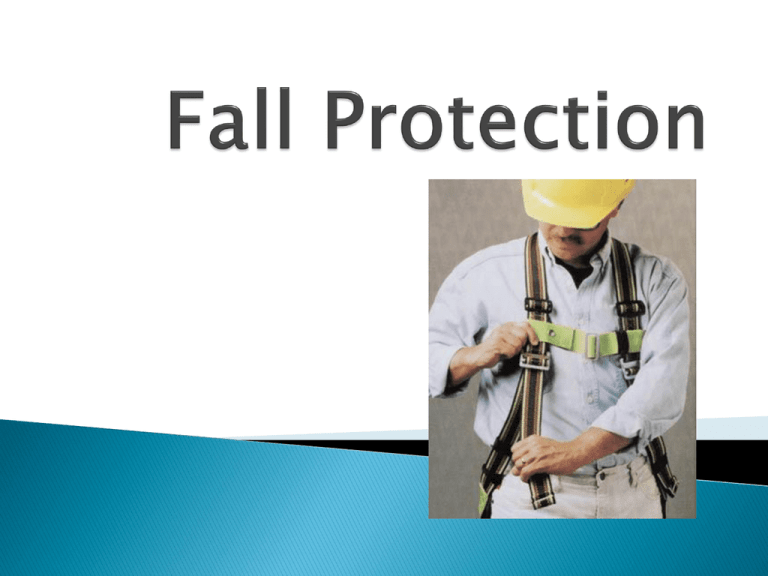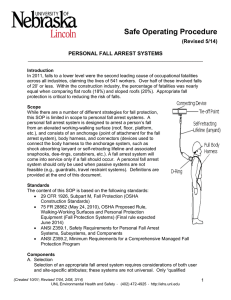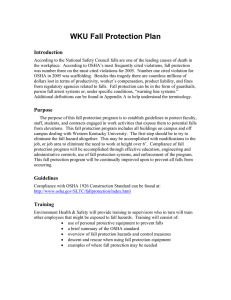Fall Protection
advertisement

Falls level ◦ ◦ ◦ ◦ from same Slips Trips High frequency rate Low injury severity rate 1a Falls from an elevation ◦ Relatively low frequency rate ◦ High injury severity rate Specific potential fall hazards 1b Guardrail systems and toeboards Handrail and stair rail systems Designated areas Hole covers Safety net systems Ladder cages Ramps and bridging devices Slip-resistant floors Effective housekeeping 2a A person loses balance, and unintentionally moves from an upright to a prone/semi prone position Free-fall velocity at impact when falling 12 feet is nearly 20 M.P.H. Person hits the ground in less than one second from this distance…we fall fast 3b Falls are dangerous because of three primary elements: The free-fall distance the worker falls The shock absorption at impact The body weight of the worker 4a The uncontrolled length of travel before a worker hits the floor, ground, or before fall arrest equipment activates Measured from the foot level before the fall, to the foot level after the fall Should be controlled as much as possible. Keep it at a minimum 5a Varies according to the types of fall protection equipment used Shock-absorbing lanyards (Rope threaded through a pair of deadeyes) reduce the probability of injury 6a Falls have more severe impact on heavy workers “The bigger they are, the harder they fall.” Heavy workers may have larger waistlines, preventing fall arrest equipment from fitting properly 7a Used when engineering controls are not feasible or sufficient to eliminate the risk of a fall Fall arrest systems: ◦ prevent a worker from falling more than 6 ft ◦ prevent a worker from contacting any lower level during arrest of a fall ◦ Should not consist of body belts and non-locking type snap hooks 8b Fall arrest systems should: ◦ limit the maximum arresting force on an employee to 1800 pounds when a worker uses a body harness ◦ bring a worker to a complete stop ◦ limit the deceleration distance a worker travels to 3 1/2 feet ◦ have sufficient strength to withstand twice the potential energy impact of a worker falling a distance of 6 feet - or◦ have sufficient strength to withstand the free-fall distance permitted by the system, whichever is less 8c Personal fall arrest systems that as a minimum consist of body wear, connecting device and anchorage connector Positioning device system Personal fall protection system for climbing activities 9a Controlled access zones are areas where certain work may be done without the use of guardrails, personal fall arrest systems, or safety nets. However, unlike a warning line, which is barrier that cannot be crossed, a controlled access zone establishes a boundary that can be crossed, but only by a specifically designated employee. 10a Key systems within this group include: Guardrail Systems Hole Covers (For holes over 1” in size) Safety Nets Personal Fall Arrest Systems Positioning Systems Personal Fall Restraint Systems for Climbing Activities 10a Equipment Application Methods inspection limits of use Donning, doffing, adjusting equipment 10a Anchoring Emergency and tie-off techniques rescue plans and implementation Maintenance Storage procedures techniques 10b Comprehensive instructions for fall arrest system use and application, provided by the supplier, should consist of: 11a The force measured during the sample force test Maximum elongation measured for lanyards during the force test Deceleration distance for deceleration devices measured during the force test Caution statements on critical-use limitations Application Limits Proper hook ups Anchoring tie-off techniques Proper climbing techniques Basically everything you should know. Read the supplier information. 11b Employees will not experience repercussions from reporting hazards Employees should report unsafe equipment, conditions, procedures Equipment repair must receive top priority Under no circumstances will defective equipment be used 12a Equipment repair must receive top priority Under no circumstances will defective equipment be used 12b When fall conditions exist: ◦ Take short steps ◦ Keep toes pointed out ◦ Walk on the whole foot when crossing rough or slippery surfaces ◦ Avoid making sharp turns ◦ If you fall, protect your head and neck 12c Employees can be exposed to disciplinary actions for failure to use fall protection equipment 12d Our Facility Our company’s safe work practices regarding fall protection include the use of appropriate harness. If a fall does start to happen, the best way to deal with it is to relax, go limp, and not resist the fall. Remember, this is for your safety, so if you fall, don’t panic. Keep calm, and let the harness do the rest. Effective housekeeping prevents falls Keep high work areas free from: ◦ ◦ ◦ ◦ Tools Materials Debris Liquids 13a








